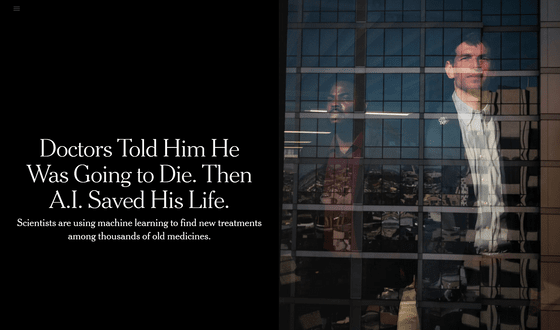AI suggests repurposing medicines, successfully treating people with rare diseases with few options

The New York Times cites several examples of cases in which AI has suggested new treatments and doctors have provided guidance on how to treat rare diseases, leading to improved symptoms and even remission.
AI Saved His Life by Discovering New Uses for Old Drugs - The New York Times

The National Institutes of Health in the United States defines a rare disease as one that affects fewer than 200,000 people in the United States, but there are thousands of rare diseases, and more than 90% of them have no approved treatment. AI is being used as a way to find treatments for these diseases.
The first case to be covered by The New York Times was that of Joseph Coates, who lives in the United States. Coates developed a rare disease called
Just when Coates had given up hope, his girlfriend, Tara Theobald, decided to send an email to Dr. David Fajgenbaum in Philadelphia asking for help. Within a day, he replied, proposing an unconventional combination of chemotherapy, immunotherapy and steroids to treat Coates' disease.
After trying this treatment, Coates' condition improved enough that he was able to undergo a stem cell transplant four months later and later went into remission.

The treatment that Dr. Fajgenbaum suggested was exactly what the AI had suggested.
Dr. Fajgenbaum is a researcher who is working to unlock the potential of existing medicines and apply them to unconventional diseases, and is co-founding the non-profit organization Every Cure to focus on discovering the potential of medicines. As a medical student, Dr. Fajgenbaum developed a rare disease called Castleman disease and was in critical condition. As there were limited treatment options, he began working on a treatment that repurposed existing
Dr. Fajgenbaum is taking an AI-based approach through Every Cure, harnessing the processing speed that machine learning brings to search for new treatments. The success of these efforts has other researchers beginning to wonder if there are potential treatments for other diseases.

According to the New York Times, drug repurposing is common, for example, minoxidil, which was developed as a blood pressure lowering drug, has been repurposed to treat hair loss. In Dr. Fajgenbaum's case, the drug that cured his disease was a generic drug called sirolimus, which is used to prevent rejection in kidney transplant patients, not to treat Castleman's disease.
Similar research to Every Cure is being conducted around the world, including in the United States, Japan, and China. In Birmingham, Alabama, an AI suggested to a 19-year-old patient who was debilitated by chronic vomiting, 'Try inhaling isopropyl alcohol through your nose.' When he did so, it was immediately effective. Matt Might, who learned about this treatment from the AI, said, 'I sent a prompt saying, 'Show me all the treatments proposed in medical history that are effective for nausea,' and isopropyl alcohol came out at the top of the list.'
Might has customized the AI model himself, and it has been used to suggest new treatments for other patients, such as helping a paralyzed patient improve their condition with ADHD medication and helping a neurological patient improve their condition with blood pressure medication.
'Using AI to identify potential medicines is really exciting,' said Dr. Grant Mitchell, co-founder of Every Cure and a classmate of Dr. Fajgenbaum's. 'It could help a lot of people.'
Related Posts:
in Software, Posted by log1p_kr







